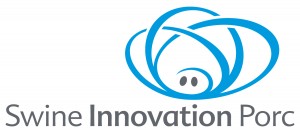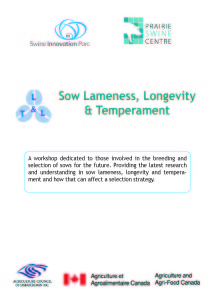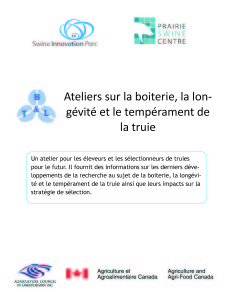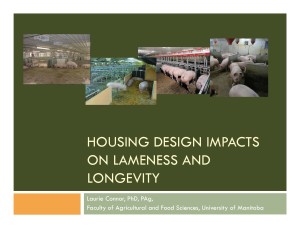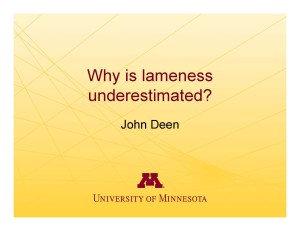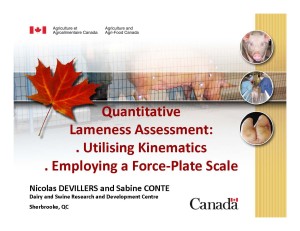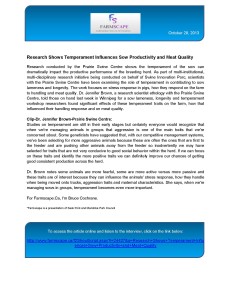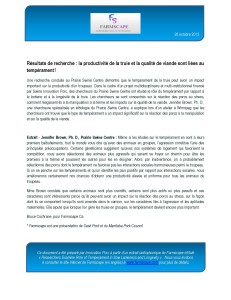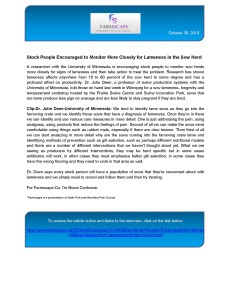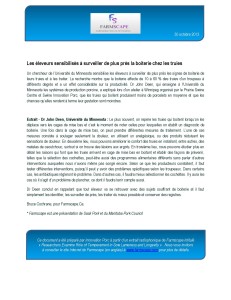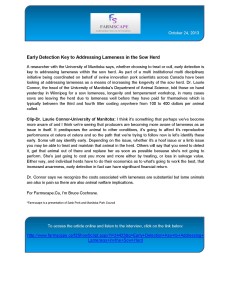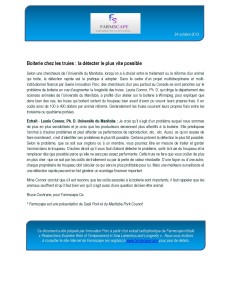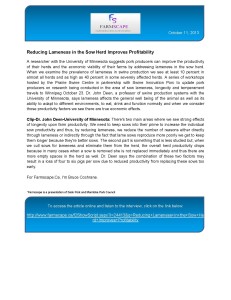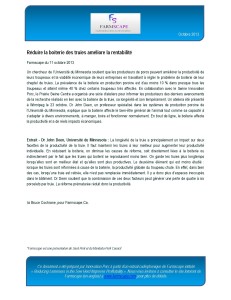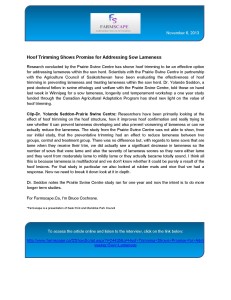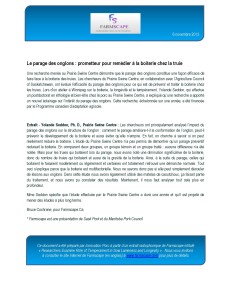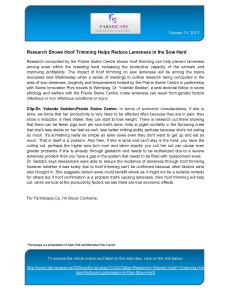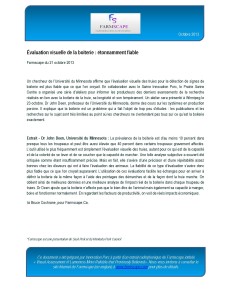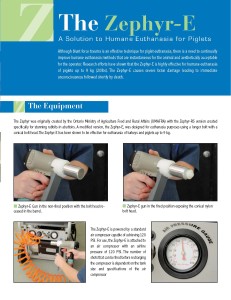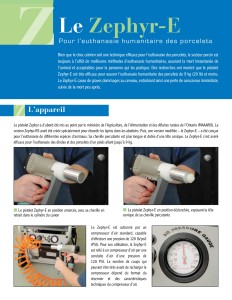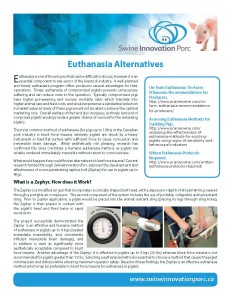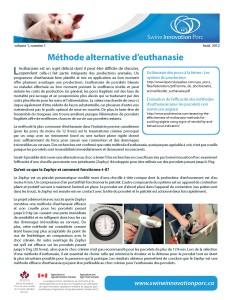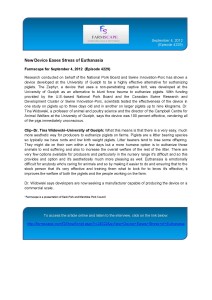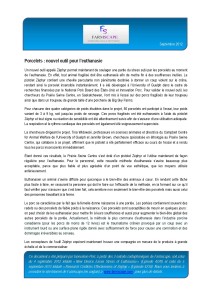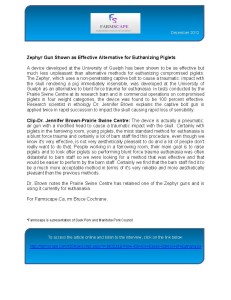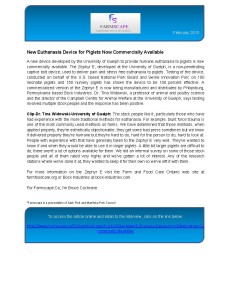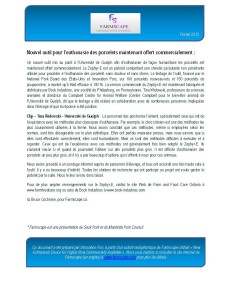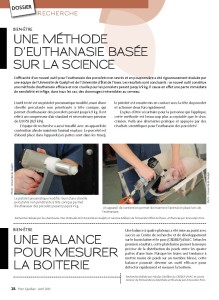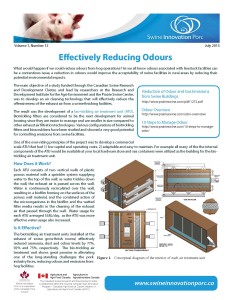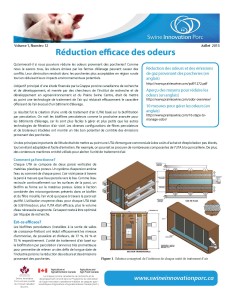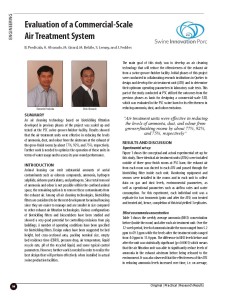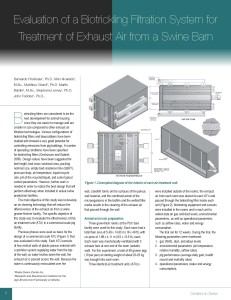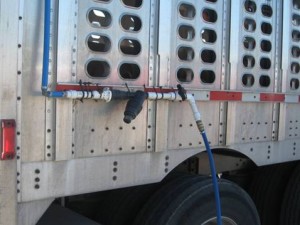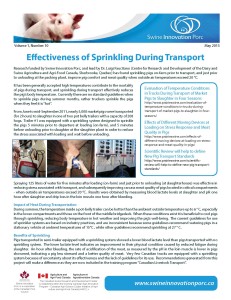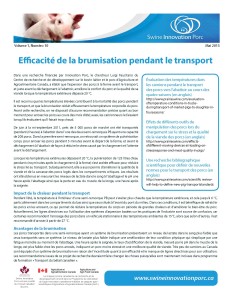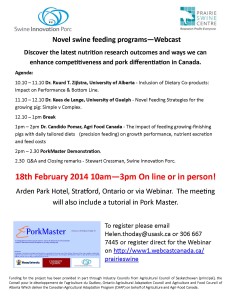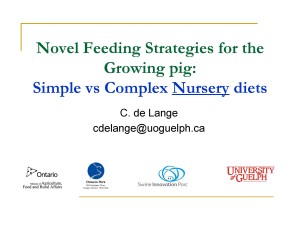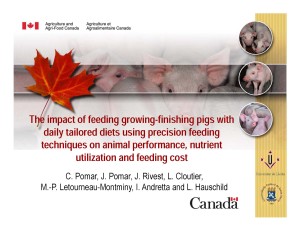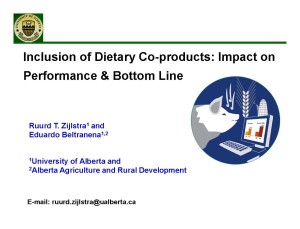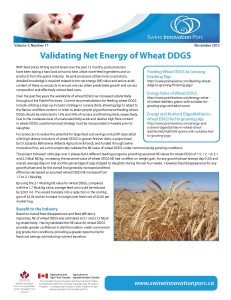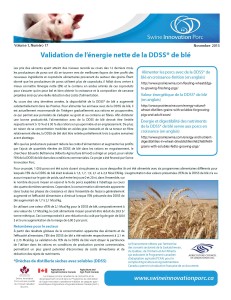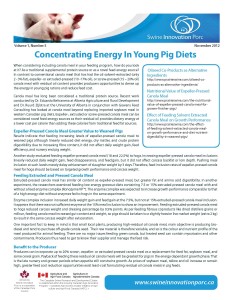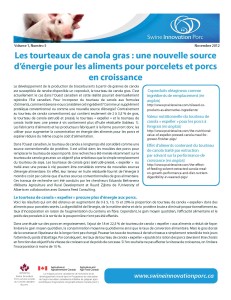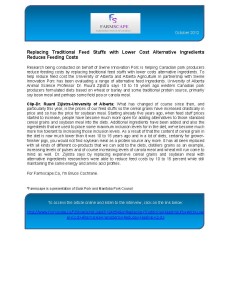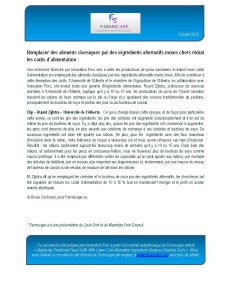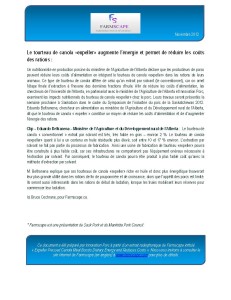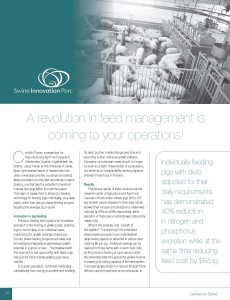Évaluer différentes stratégies de contrôle de température ambiante en engraissement porcin en vue d’optimiser les performances zootechniques et de réduire la consommation d’énergie et les émissions gazeuses
Posted in: Swine Innovation by admin on September 25, 2012 | No Comments
Proposer une stratégie de contrôle de la température optimale dans les engraissements porcins dans un contexte d’agriculture durable et de bien-être des animaux
- Évaluer l’impact de trois différentes stratégies de contrôle de la température ambiante sur les performances zootechniques des porcs;
- Effectuer et comparer le bilan énergétique (consommation d’énergie) entourant le besoin de chauffage durant les périodes froides pour chacune des stratégies testées;
- Évaluer l’impact des stratégies de contrôle de la température ambiante sur les concentrations et les émissions de gaz;
- Évaluer l’impact des stratégies de contrôle sur la qualité de la carcasse;
- Calculer les impacts économiques des stratégies de contrôle et indiquer les impacts sur le coût de production;
- Déterminer la stratégie optimale en regard des paramètres étudiées;
- Diffuser les résultats auprès des conseillers, intervenants et producteurs.
Développer des concepts de ventilation permettant de minimiser les débits d’air requis durant la période estivale en maternité et en engraissement
Posted in: French Articles, Swine Innovation by admin on | No Comments
Développer et tester des concepts de ventilation en maternité et en engraissement afin de minimiser les débits d’air requis durant les périodes chaudes sans affecter les performances zootechniques et le bien-être des animaux. Au final, le but est de réduire les coûts liés à l’implantation de systèmes de filtration d’air à l’intérieur de bâtiments porcins de type naisseur et naisseur-finisseur
- Concevoir et évaluer l’efficacité de différents concepts de ventilation permettant d’optimiser les débits d’air et le refroidissement des porcs durant la saison chaude;
- Évaluer l’impact des différents concepts de ventilation à débit d’air réduit durant les périodes chaudes en maternité et en engraissement sur :
- Les paramètres d’ambiance (température, humidité et vitesse d’air) dans les bâtiments;
- Les performances zootechniques et le bien-être des animaux;
- Les coûts liés à l’implantation de système de filtration de l’air;
- Les coûts liés à l’implantation des systèmes de ventilation;
- La consommation d’énergie;
- La consommation d’eau liée au fonctionnement de systèmes de refroidissement.
Breakthroughs in Canadian Swine Nutrition
Posted in: Pork Insight Articles, Swine Innovation, Uncategorized by admin on September 19, 2012 | No Comments
Precision livestock farming is an innovative production system approach, which is based on intensive and integrated use of advances in animal sciences and in the new technologies of information and communication (Berckmans 2004). Its main objective is to optimize animal production and the management of the productive processes (Groot Koerkamp et al. 2007). Today, this approach offers many opportunities, such as the increased feed efficiency that can be obtained by reducing uncertainty in decisions relating the control of the variability that exists among farm animals (Wathes et al. 2008). A relevant contribution in this regard of precision pig farming is the development of precision feeding systems (Niemi et al. 2010; Pomar et al. 2009) which lays the groundwork for addressing key issues in today intensive livestock farming which are: (1) reducing feeding cost by improving feed and nutrient efficiency (2) improving production system sustainability by increasing profitability and reducing production footprints and (3) increasing food safety through traceability. This paper presents key elements for the development of sustainable precision livestock farming and a vision for the future of the Canadian swine industry.
Feeding rather simple, corn and soybean meal based diets to nursery pigs reduced post-weaning growth performance, but had no long-term effect on growth performance in the growing-finishing phase, days from weaning to market and carcass characteristics. Therefore, a reduction in feed costs may be obtained in the nursery phase by feeding less complex diets without compromising subsequent growth performance and carcass value.
Detailed nutritional analyses and in vitro nutrient digestibility and availability assays confirm the substantial variability in nutritional value of corn distillers grains plus solubles (DDGS) that are used in Ontario. While color provides a reasonable prediction of the nutritional value of individual sample of DDGS, especially the available lysine content, this simple measurement has limitations. Given the relatively high fiber content of DDGS, fiber-degrading enzymes and microbial inoculants may be used to enhance the nutritional value of corn DDGS. The combined use of exogenous enzymes and inoculants appears more effective at enhancing the feeding value of corn DDGS in liquid-fed finishing pigs than in conventional dry feeding.
This topic is broad. Therefore, the emphasis is on parts of the program funded by the Canadian Swine and Research Development Cluster and industry partners that is focussed on changes in diet formulation that: 1) alter the profile of feedstuffs to less grain and more co-products from processing of crops or 2) alter the profile of dietary carbohydrates (starch and fibre). These two parts are linked: the changes in feedstuffs by default will change dietary profile of carbohydrates to more fibre and less starch. Dietary feedstuffs play an important role in feed costs and thus competitiveness. Functional characteristics of carbohydrates, digestion patterns of starch and fermentation patterns of fibre, play an important role in value-added attributes such microbial profile in the gut and thus intestine health; however, such characteristics are not used widely yet in feed formulation.
The fate of dietary phosphorus in the digestive tract of growing pigs and broilers
Posted in: Pork Insight Articles, Swine Innovation by admin on August 9, 2012 | No Comments
It is crucial to understand the requirements and availability of dietary phosphorus to be able to limit its use. There are big environmental and economically reasons to reduce the use of dietary P but it must be done while not impacting growth. As a prerequisite to understanding dietary P one should understand the fate of ingested P, its interaction with dietary calcium, and exogenous phytase supply. Understanding these criteria researchers were able to build a mathematical model based on in vitro and in vivo literature data. The model has 3 sections which successfully occur: 1. P solubilisation and phytic P hydrolysis, 2. P absorption and 3. P insolubilisation. To better understand key factors of P utilization parameterisation of equations was used in both pigs and chickens. Sensitivity analysis indicated that P solubilisation/insolubilisation and especially phytic P solubilisation prior to hydrolysis by phytase were sensitive to pH and dietary Ca supply. Behavioral analysis found that the model was able to predict the lower plant phytase in both pigs and chickens. The model correctly predicted apparent digestibility in pigs. The model offers the potential to be combined with a metabolic model that integrates regulation of P and Ca metabolism.
Euthanasia Alternatives
Posted in: Pork Insight Articles, Swine Innovation by admin on July 31, 2012 | No Comments
Euthanasia is essential for overall herd health and production costs, as unhealthy and unprofitable pigs are removed from the herd. For young pigs, blunt force trauma is the method most commonly used through-out the industry. Blunt force trauma is effective and in compliance with regulations, but it is not very pleasing aesthetically. A more visually pleasing alternative to blunt force trauma is a zephyr gun, which is a modified air gun that rapidly fires two 9mm depressions on the pigs head, rendering them insensible. The zephyr gun has been proven to be affective and can be used on pigs up to 9kgs (20lbs) where blunt force trauma is only acceptable up to 12lbs. The Zephyr is considered an effective euthanasia method which may be preferable to blunt force trauma for euthanasia of piglets.
Towards Integration Nutritional Management of Growing-Finishing Pigs
Posted in: Pork Insight Articles, Swine Innovation by admin on July 26, 2012 | No Comments
The University of Guelph has compiled research to improve nutritional management in growing-finishing pigs. The objectives of there research include improving efficiency/profitability of pork production, improve pork quality and safety, minimize environmental impact, and reduce reliance on in-feed medication. With these objectives as guides, research updates are provided for three projects: The first being Long-term impact of post-weaning feeding programs. There are opposing views on post-weaning feeding programs, one view argues strong growth post-weaning leads to strong growth thereafter, while the other view believes a poor diet and growth post-weaning will lead to compensatory growth resulting in the same outcome with lower feed costs. The research attempts to evaluate the effects of a complex diet and in-feed antibiotics versus a simple diet on nursery pigs and how it impacts grow-finish growth performance and carcass quality. Pigs were put on either a simple or complex diet, and tracked through their barn cycle. Results found that reduced gain in the nursery due to reduced diet complexity or feeding antibiotics did not effect days from weaning to market, gain to feed ratio from weaning to market, or carcass composition. The second project that is reported on is Variability of (Ontario) DDGs. Researchers attempt to assess the variability in nutrient characteristics of DDGS and to identify predictors of nutritional value. Twelve samples from each of seven sources were used. Results found that there was a large difference between and within processing plant differences, also conventional amino acid analyses overestimate reactive lysine by about 17%. The third project Decision Support System to evaluate the environmental & financial impacts of alternative management strategies attempts to identify and implement an optimum management strategy by further developing the pig growth model developed by the International Pig Growth Modelling Group, lead the development of models for “Nutrient requirements of swine” and explore aspects of nutrient utilization.
Assessing the Effectiveness of Euthanasia Methods for Suckling Piglets Using Signs of Sensibility and Behavioural Indicators
Posted in: Pork Insight Articles, Swine Innovation by admin on | No Comments
Euthanasia is a practice in pig production that has welfare and economic impact. It is essential to understand when euthanasia should be carried out and that it is done properly to limit suffering of the pig. Early weaning of compromised piglets has both welfare and economic benefits. When a pigs birth weight is less than 0.9kgs it will rarely turn into profit for the producer so euthanasia will limit feed and maintenance costs and improves overall herd welfare. For pigs under twelve pounds there are three acceptable euthanasia methods, blunt force trauma, overdose on anesthesia and CO2 poisoning. Blunt force trauma is the most common method and fairly simple to carry out, but aesthetically it is not the most ideal method. An alternative to BFT is a non-penetrating captive bolt which has been deamed acceptable for suckling pigs. Co2 poisoning involves exposing a pig to greater than 90% CO2 for five minutes. Although this method is effective at causing death, it can appear inhumane as pigs squeal while being gassed, try to escape, and have high cortisone levels which suggests the pig has suffered increased stress. When choosing a euthanasia procedure producers should have clear guidelines about which piglets should be euthanized as well as how the procedure is carried out. To assess sensibility the pigs should be tested immediatly after the euthanasia. If the pig still has a brain or spinal reflex it is still considered sensible and the euthanasia attempt must be repeated. If physical contact is not possible behavior tests can be done by obseving absence of breathing, lack of muscle tone and abasence of vocalization.
POSTER – Development of new genomic tools to improve meat quality traits and production efficiency in pigs
Posted in: Pork Insight Articles, Swine Innovation by admin on July 24, 2012 | No Comments
Recently the Canadian pork industry has had made available many high-density SNP’s. This has led to opportunities to improve meat quality and other characteristics in pig herds. The new technology will allow producers to genetically select pigs that have desireable traits like good feed efficiency, which is expensive to measure, and meat quality, which is something that now can only be assessed after a pig has be slaughtered. This has potential to let producers select pigs that are better suited for the market they are in, improve accuracy in selecting econmically beneficail pigs and help differentiate Canadain pork.
Assessment of Lameness, Productivity and Longevity in Group and Individually Housed Gestating Sows
Posted in: Pork Insight Articles, Swine Innovation, Welfare by admin on July 23, 2012 | No Comments
Sow housing is the dominant issue when discussing animal welfare in pig production. Converting away from gestation crates carries several factors that must be considered, such as sow welfare and longevity in the herd, as well as their economic sustainability. Lameness sows is one of the main reasons for culling otherwise productive sows and will be important to gauge properly when considering alternative housing methods. The objective of this study is to determine the relationship among variables such as body weight, age, social rank, body condition and health status, and degree of lameness on success within the different systems based on relative productivity, culling rate, health changes, aggression and injuries. To asses lameness four methods will be used: Complex gait scoring, kinematics, accelerometers, and a forced plate weight scale. Sow temperament will be measured by 4 tests: the Open Door Test, Pig Approaching Human , Human Approaching Pig and Novel Object Test. To measure sow longevity sows will be assessed on lameness and sow condition on the 7th, 16th, and 20th week post breeding. The need to monitor and assess animal welfare standards on commercial farms is becoming an increasingly important issue as quality assurance schemes are expanded in response to consumer demands.
Swine Innovation Porc – Lead User Program
Posted in: Pork Insight Articles, Swine Innovation by admin on April 30, 2012 | No Comments
The objectives of the lead-user program are to build upon the Canadian Swine research and Development Cluster research program (funded through growing Forward 1), through speeding the rate of adoption of new technologies. Early adoption of some of these new technologies are designed to enhance the competitiveness and differentiation of the pork industry throughout Canada.
Presentations from the seminar are also available on-line. Please click the following link to view the archived presentations
PorkMaster can be downloaded free of charge. Please click on the PorkMaster logo for download instruction and a copy of the user manual.
Funding for the project has been provided in part through Industry Councils from Agricultural Council of Saskatchewan (principal), the Conseil pour le développement de l’agriculture du Québec, Ontario Agricultural Adaptation Council and Agriculture and Food Council of Alberta Which deliver the Canadian Agricultural Adaptation Program (CAAP) on behalf of Agriculture and Agri-Food Canada.










